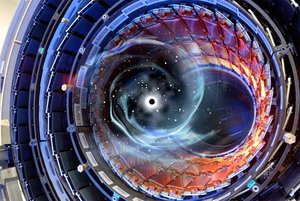CERN has not improved LHC safety and thus accepts possible existential risks while doubling the collision energy levels
LHC-run is a scandal for humankind and science!
CERNs main contradiction can be put in simple words. CERN says: We are producing matter and conditions that existed fractions of a second after the Big Bang. We have got no clue what the outcome of doing this will be. But at the same time we are sure that nothing dangerous will happen.
In effect, CERN simply accepts residual (?) existential risks to planet Earth and humanity, pretending to the public that everything is pretty safe.
During the upgrade of the LHC that cost hundreds of millions, CERN has not put in place a single safety measure proposed by critics. The main safety measures would be:
Conducting an interdisciplinary safety assessment of the LHC - independent from CERN and involving the science of risk research and the sociology of science.
A step by step increase of the collision energies which possibly could show warning signs of unexpected and dangerous collision products.
Without taking any of these safety measures, CERN smashes particles at double the previous levels of energy. This poses hopefully small, but fundamentally unpredictable catastrophic risks to planet Earth.
CERNs main safety argument compares the LHC-experiment to natural particle collisions happening daily in the atmosphere, though science does not even know the sort of the most energetic natural particles. And even if CERNs figures are right, the LHC will produce as many high energy collisions as happen within hundreds of thousands of years in the entire Earths atmosphere. The LHC-beam, thinner than a hair, has got the energy of a high speed train. So: Nature does not conduct LHC-experiments.
To be clear: If humankind has got ’bad luck while putting itself at risk, CERN right now could produce ’Micro Black Holes that do not ’evaporate (as planned by Stephen Hawking and CERN) but that could be trapped by the Earths gravity and grow at an unpredictable rate according to several theories. Furthermore, the planned heavy ion (Pb-Pb) collisions at the end of the year (November 2015) will increase the risk of a disastrous ’strangelet (ICE-9 reaction) that could transform planet Earth to a dense ball of strange matter at the worst case. Furthermore, the same experiments will increase the risk of a ’vacuum transition (vacuum bubble at the speed of light) that could endanger the entire space we know.
Further explanation:
Basically the same group of critics, including professors and doctors, that had previously filed a law suit against CERN in the US and Europe, still opposes the restart for basically the same reasons. The dangers of: (’Micro-) Black Holes, Strangelets, Vacuum Bubbles, etc., etc. are of course still in discussion, and may always be in discussion. Meanwhile no specific improvements concerning the safety assessment of the LHC have been made by CERN or anybody else. There is still no proper, full and truly independent risk assessment (the 'LSAG-report' has been done by CERN itself) - and the science of risk research is still not really involved in the issue. This is a scientific and political scandal and thats why the restart was a sad day for science and humanity.
High energy experiments like the LHC at the nuclear research centre CERN are extreme energy consumers (needing the power of a nuclear plant). Their construction is extremely costly (presently 7 Billion Euros) and no practical benefits are in sight. The experiments pose potential existential risks and these risks have not been properly investigated.
There are countless evidences for the necessity of an external and multidisciplinary safety assessment of the LHC. According to a pre-study in risk research, CERN fits less than a fifth of the criteria for a modern risk assessment. It is not acceptable that the clueless member states point at the operator CERN itself, while CERN regards its self-set security measures as sufficient, in spite of critique from risk researchers, continuous debates and the publication of further papers pointing to concrete dangers potentially arising from the experiments. Presently science has to admit that the risk is disputed and basically unknown.
It will not be possible to keep up this ostrich policy much longer. Especially as they face further planned upgrades of the LHC and the possible construction of further particle accelerators, CERN, the community of physicists and the involved member states will be confronted with an increasing critique from the scientific and civil side that the worlds most powerful particle collider has not yet been challenged by a neutral and multidisciplinary safety assessment. CERN has not yet responded to pragmatic proposals for such a process that should constructively involve both critics and CERN itself. Also further legal steps from different sides are still possible though such questions cannot be solved by courts alone.
This is why we rather call upon the member states that are financing the CERN budget, the UN and/or private funds to provide resources to finally initiate a neutral and multidisciplinary risk assessment of giant particle accelerator risks. Without that, ’Big Bang Machines like the LHC actually should not operate at all. Also, CERN critics oppose any public funding of this research.
The next billions of years will be hard enough without CERN.
Author and further informations: LHC Critique
Artikel Online geschaltet von: / stevanov /
